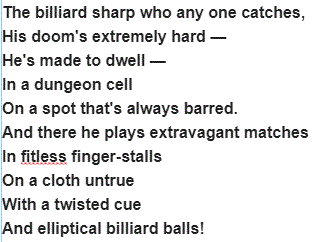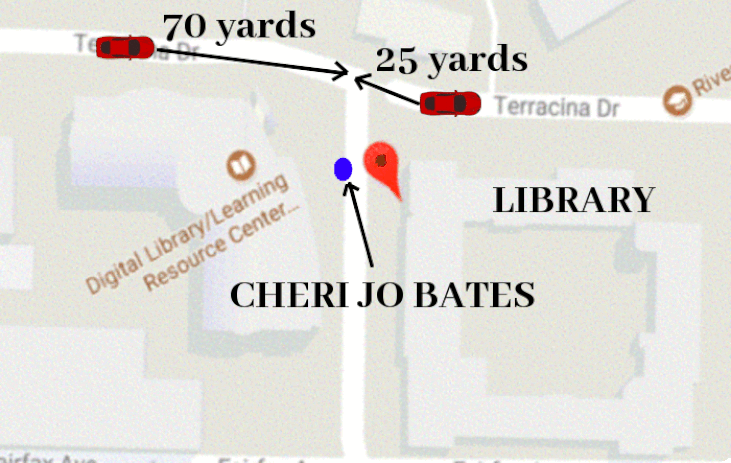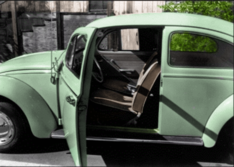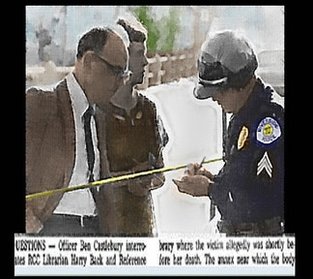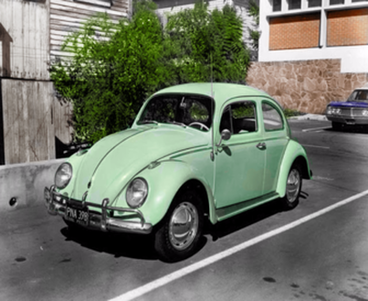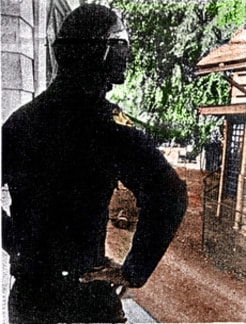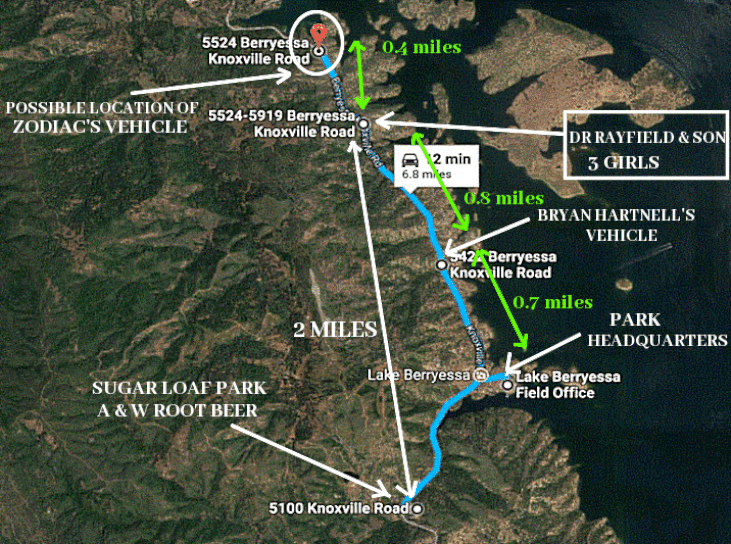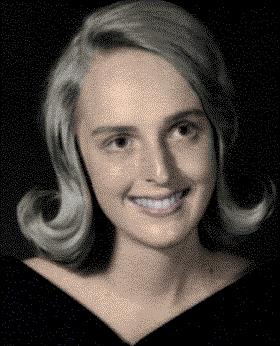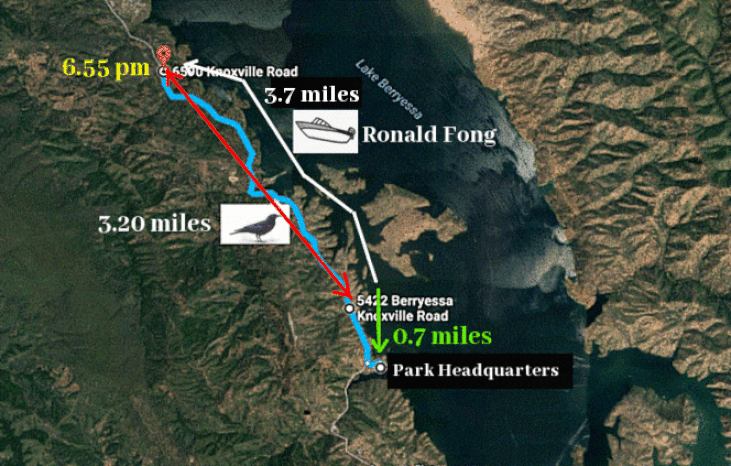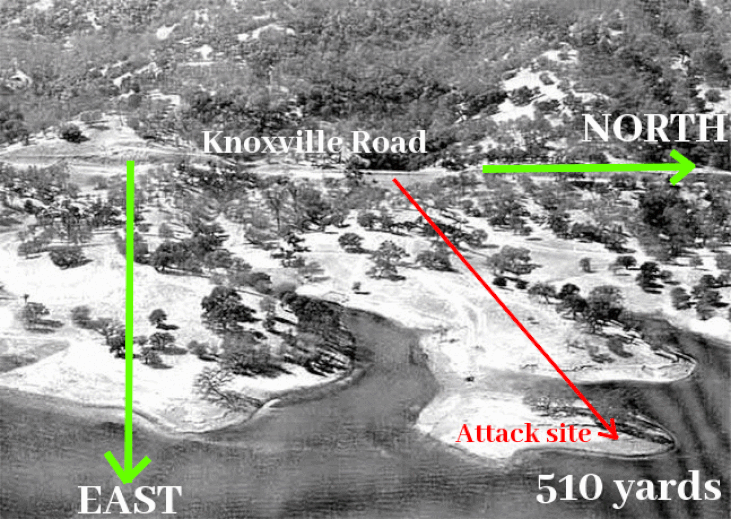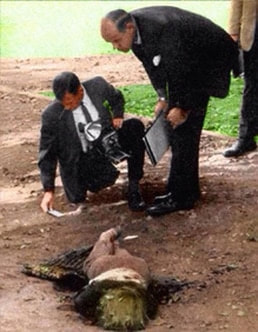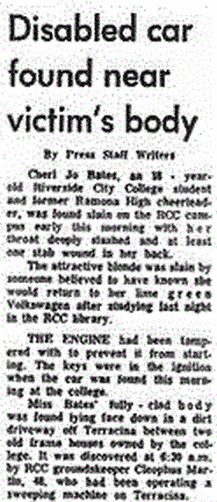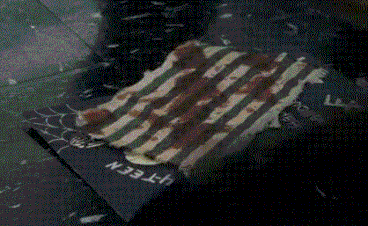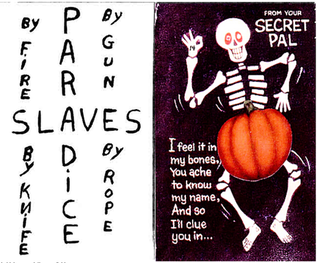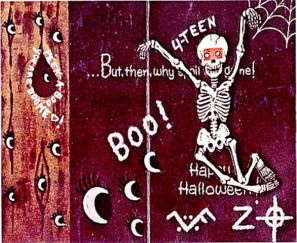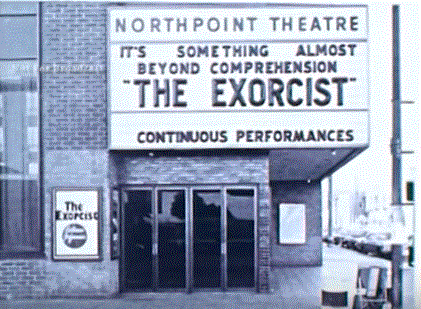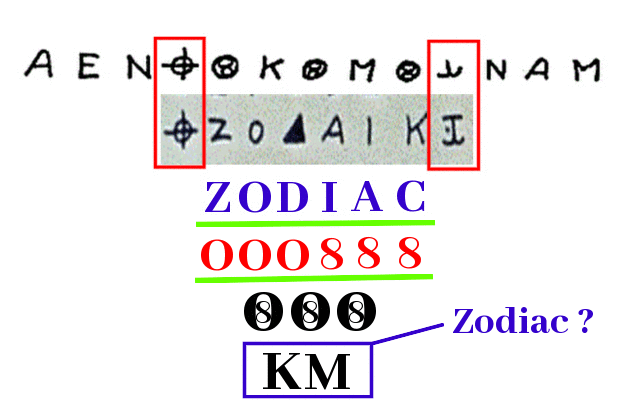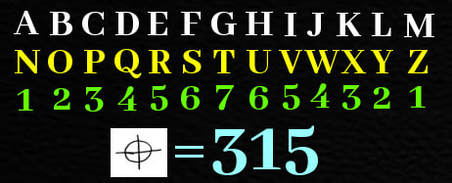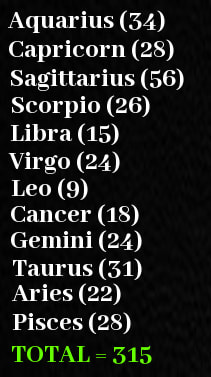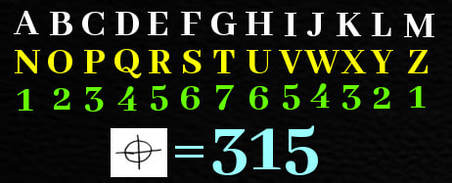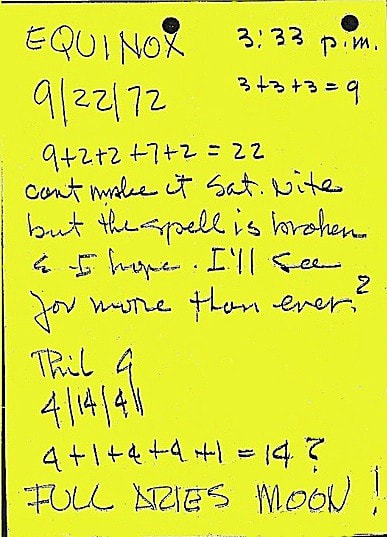The first three crimes of Lake Herman Road, Blue Rock Springs Park and Lake Berryessa were committed in situ, in that the Zodiac Killer attacked the couples where he discovered them. The Zodiac at Presidio Heights entered the taxicab of Paul Stine in the bustling theater district of San Francisco and murdered him at Washington and Cherry, although Paul Stine effectively remained in situ, within the taxicab throughout. The three crimes that have widely been attributed to Zodiac, are the Riverside murder of Cheri Jo Bates, the Modesto abduction of Kathleen Johns and the disappearance of Donna Lass from the Sahara Tahoe Casino, all of which were followed by alleged communications from the Zodiac Killer. These three crimes had one thing in common, the perpetrator used a ruse, to lure the women into his vehicle and remove them from the first point of contact. Cheri Jo Bates' car distributor was tampered with, followed by the promise of a lift home, to lure the young woman into his vehicle. Kathleen Johns, again would fall prey to the same tactic, her wheel was tampered with, followed by the promise of a lift to a service station. Donna Lass was lured away from her place of work, by a false medical emergency, to again draw the nurse toward his vehicle. Three crimes, involving three young women, and in all instances similar tactics were employed, followed by a correspondence claiming the crime. Here though, it is the Donna Lass abduction we shall concentrate on.
In the aftermath of the disappearance, the search for Donna Lass would be badly affected by the inclement weather in the coming months, highlighted by Police Chief Ray Lauritzen in the newspapers from the outset: "We don't know where we're going to begin. There's a four or five foot pack of snow out there and it's still snowing heavily. There's no point to a search at this time. It's unlikely a victim would be uncovered before spring."
The Zodiac Killer, we know, was an avid reader of the newspapers, and it is likely he also read this statement by Chief Ray Lauritzen. It is possible the 'Pines' card, mailed on March 22nd 1971 was a direct response to this article, but in a very subtle way. This we will come to later.
In the aftermath of the disappearance, the search for Donna Lass would be badly affected by the inclement weather in the coming months, highlighted by Police Chief Ray Lauritzen in the newspapers from the outset: "We don't know where we're going to begin. There's a four or five foot pack of snow out there and it's still snowing heavily. There's no point to a search at this time. It's unlikely a victim would be uncovered before spring."
The Zodiac Killer, we know, was an avid reader of the newspapers, and it is likely he also read this statement by Chief Ray Lauritzen. It is possible the 'Pines' card, mailed on March 22nd 1971 was a direct response to this article, but in a very subtle way. This we will come to later.

It is far from certain the perpetrator of this crime knew Donna Lass, but the following will explore reasons why this may be the case.
Similar to the second and third crimes by the Zodiac Killer, the disappearance of Donna Lass was again followed by a phone call from the supposed perpetrator. But unlike Blue Rock Springs Park and Lake Berryessa, this phone call didn't brag about his crime, it claimed Donna Lass had been 'called away' or 'called out of town' due to a family illness, all of which was subsequently proved to be false. The caller was seemingly trying to give the impression nothing sinister had happened, suggesting the act of the phone call was simply to 'buy time'. If the abductor was affording himself some extra breathing space, then the real possibility he was local to the area or known to Donna Lass is a credible argument, and he was either holding Donna Lass at this juncture, needed time to dispose of her body, or possibly needed to remove incriminating evidence from his home or vehicle before the police came knocking. This may have suggested that the responsible moved in the circle of Donna Lass, such as friends and work colleagues, who are inevitably the first people to be questioned in most police investigations.
The nature of the call was also suggestive of a perpetrator who knew Donna Lass. A friend or work colleague through conversation or private details, would be privy to information about her family, and the fact they lived in Sioux Falls, South Dakota, 1,555 miles away. A phone call in this instance, using a family illness as a ruse, would be of the utmost benefit to the caller, possibly 'buying' the perpetrator plenty of time. The caller it would seem, knew her family did not reside in South Lake Tahoe or nearby, because this would have made the call ineffectual.
Two phone calls were laid, one to her employer and one to her landlord. The first would obviously explain her absence from work after the Labor Day weekend, the second would possibly allay the concerns of her landlord over rent collection. He may have known Donna Lass, but would unlikely have known the exact date her payments were due. The fact he called her landlord at all, is indicative of somebody who was familiar with Donna Lass, unlikely to be known by a random killer or abductor, who just turned up at the Sahara Tahoe Hotel that morning. If the perpetrator was the Zodiac Killer, then his close ties to Donna Lass could be of crucial importance, bearing in mind the widely held belief he was unknown to his victims in the first four confirmed attacks in the Bay Area. If the Zodiac Killer was also known to Cheri Jo Bates, due to the specific targeting of her Volkswagen Beetle, then Riverside and South Lake Tahoe may be more closely linked than ever imagined.
Similar to the second and third crimes by the Zodiac Killer, the disappearance of Donna Lass was again followed by a phone call from the supposed perpetrator. But unlike Blue Rock Springs Park and Lake Berryessa, this phone call didn't brag about his crime, it claimed Donna Lass had been 'called away' or 'called out of town' due to a family illness, all of which was subsequently proved to be false. The caller was seemingly trying to give the impression nothing sinister had happened, suggesting the act of the phone call was simply to 'buy time'. If the abductor was affording himself some extra breathing space, then the real possibility he was local to the area or known to Donna Lass is a credible argument, and he was either holding Donna Lass at this juncture, needed time to dispose of her body, or possibly needed to remove incriminating evidence from his home or vehicle before the police came knocking. This may have suggested that the responsible moved in the circle of Donna Lass, such as friends and work colleagues, who are inevitably the first people to be questioned in most police investigations.
The nature of the call was also suggestive of a perpetrator who knew Donna Lass. A friend or work colleague through conversation or private details, would be privy to information about her family, and the fact they lived in Sioux Falls, South Dakota, 1,555 miles away. A phone call in this instance, using a family illness as a ruse, would be of the utmost benefit to the caller, possibly 'buying' the perpetrator plenty of time. The caller it would seem, knew her family did not reside in South Lake Tahoe or nearby, because this would have made the call ineffectual.
Two phone calls were laid, one to her employer and one to her landlord. The first would obviously explain her absence from work after the Labor Day weekend, the second would possibly allay the concerns of her landlord over rent collection. He may have known Donna Lass, but would unlikely have known the exact date her payments were due. The fact he called her landlord at all, is indicative of somebody who was familiar with Donna Lass, unlikely to be known by a random killer or abductor, who just turned up at the Sahara Tahoe Hotel that morning. If the perpetrator was the Zodiac Killer, then his close ties to Donna Lass could be of crucial importance, bearing in mind the widely held belief he was unknown to his victims in the first four confirmed attacks in the Bay Area. If the Zodiac Killer was also known to Cheri Jo Bates, due to the specific targeting of her Volkswagen Beetle, then Riverside and South Lake Tahoe may be more closely linked than ever imagined.

Donna Lass had recently moved into the Monte Verdi apartments on 3893 Pioneer Trail Road, located just a three minute drive from the Sahara Tahoe Hotel. When she first arrived in South Lake Tahoe in June she stayed with Ann and Larry Lowe at 4054 US Highway 50, and was just finding her feet in the new residence when she went missing. Although her 1968 Chevrolet Camaro convertible was discovered outside the Monte Verdi apartment complex in its usual parking spot, it is believed she had not driven it to work on the evening of her disappearance, having walked to work from this previous residence, which was a short walking distance to the Sahara Tahoe Hotel of approximately 8-10 minutes. She had made plans to meet up with her friend Jo Anne Goettsche, intending to travel back to the Monte Verdi Apartments in her vehicle, once her shift at the casino had finished.
The fact she was targeted immediately on her shift change at around 1.50 am is also telling. Had a nurse just vanished from the start or middle of her shift, this would obviously have raised a red flag with the Sahara Tahoe Casino, negating the intention of the abductor, and most certainly rendering the phone call unnecessary and highly suspicious. She had already changed from her nurses uniform into her civilian clothes, as her shift was due to end at 2.00 am, something the perpetrator likely knew.
The last person apparently to see Donna Lass before her disappearance was a Joan Bentley from San Francisco, who stated that Donna appeared in good spirits at approximately 1.40 am. The last entry on her log according to her sister, Mary Pilker, was "patient complains of", before the pen trailed off the page. This pen mark is unlikely to have been created by her being physically manhandled from the casino, as it was extremely busy during the Labor Day weekend. More likely, is that somebody approached her nurses station and asked for medical assistance in the car park. Donna Lass may have been writing in her nurses log, when she had her arm tugged in a gesture of 'please help,' or had been in the middle of writing, when she abruptly rushed off to aid the concerned citizen. Either way, her pen trailed down the page.
The fact she was targeted immediately on her shift change at around 1.50 am is also telling. Had a nurse just vanished from the start or middle of her shift, this would obviously have raised a red flag with the Sahara Tahoe Casino, negating the intention of the abductor, and most certainly rendering the phone call unnecessary and highly suspicious. She had already changed from her nurses uniform into her civilian clothes, as her shift was due to end at 2.00 am, something the perpetrator likely knew.
The last person apparently to see Donna Lass before her disappearance was a Joan Bentley from San Francisco, who stated that Donna appeared in good spirits at approximately 1.40 am. The last entry on her log according to her sister, Mary Pilker, was "patient complains of", before the pen trailed off the page. This pen mark is unlikely to have been created by her being physically manhandled from the casino, as it was extremely busy during the Labor Day weekend. More likely, is that somebody approached her nurses station and asked for medical assistance in the car park. Donna Lass may have been writing in her nurses log, when she had her arm tugged in a gesture of 'please help,' or had been in the middle of writing, when she abruptly rushed off to aid the concerned citizen. Either way, her pen trailed down the page.

The person who made the phone call was also likely aware Donna Lass had not traveled to work that evening in her 1968 Chevrolet Camaro convertible. Had he contacted the Sahara Tahoe Hotel explaining the family illness, and that she had been called 'out of town', then this would have been negated, had her employer or work colleagues noticed her vehicle sitting idle in the car park over the next few days. A vehicle she would likely have used for her trip to South Dakota.
Was the perpetrator aware of her plans to meet Jo Anne Goettsche at around 2.00 am inside the casino, so acted just before the end of her shift. The subsequent phone call may then have served an extra purpose of allaying the worries of Jo Anne Goettsche, had she informed the casino of her concerns or contacted the police. If the perpetrator knew of Donna Lass' arrangement with her friend, he may very well have spoken to her in the preceding days, further cementing the idea he was known to the young woman.
Six and a half months after her disappearance, the 'Pines' postcard was mailed by Zodiac to the San Francisco Chronicle on March 22nd 1971. But why did the likely killer of Donna Lass wait this long to mail the communication. Did his closeness to Donna Lass play any part?
There could be another answer in the words of Police Chief Ray Lauritzen; "We don't know where we're going to begin. There's a four or five foot pack of snow out there and it's still snowing heavily. There's no point to a search at this time. It's unlikely a victim would be uncovered before spring."
The Zodiac did refer to snow in the 'Pines' card. His exact wording was "around in the snow," pasted at ground level and upside-down, possibly signifying that Donna had been buried, or placed under the snow. The snowfall was extremely heavy that winter, and it was "unlikely a victim would be uncovered before spring." Fitting then, that Zodiac contacted the newspapers on March 22nd 1971, just two days after the beginning of Spring.
Was the perpetrator aware of her plans to meet Jo Anne Goettsche at around 2.00 am inside the casino, so acted just before the end of her shift. The subsequent phone call may then have served an extra purpose of allaying the worries of Jo Anne Goettsche, had she informed the casino of her concerns or contacted the police. If the perpetrator knew of Donna Lass' arrangement with her friend, he may very well have spoken to her in the preceding days, further cementing the idea he was known to the young woman.
Six and a half months after her disappearance, the 'Pines' postcard was mailed by Zodiac to the San Francisco Chronicle on March 22nd 1971. But why did the likely killer of Donna Lass wait this long to mail the communication. Did his closeness to Donna Lass play any part?
There could be another answer in the words of Police Chief Ray Lauritzen; "We don't know where we're going to begin. There's a four or five foot pack of snow out there and it's still snowing heavily. There's no point to a search at this time. It's unlikely a victim would be uncovered before spring."
The Zodiac did refer to snow in the 'Pines' card. His exact wording was "around in the snow," pasted at ground level and upside-down, possibly signifying that Donna had been buried, or placed under the snow. The snowfall was extremely heavy that winter, and it was "unlikely a victim would be uncovered before spring." Fitting then, that Zodiac contacted the newspapers on March 22nd 1971, just two days after the beginning of Spring.



